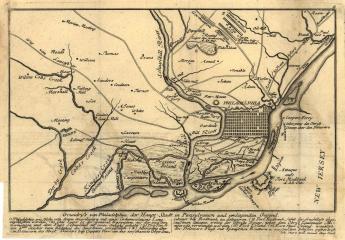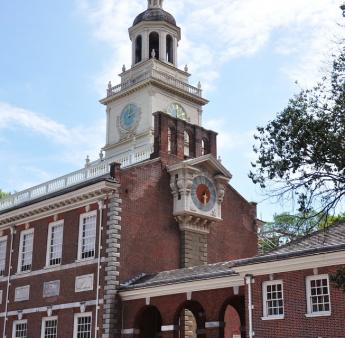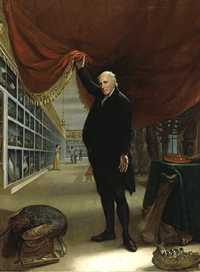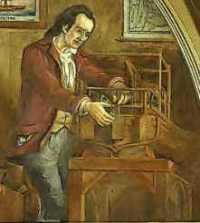Related Topics
Colonial Philadelphia (Pre- 1776)
 It's surprising to most Americans to learn the American Revolution was not the beginning, but almost half-way through the European settlement. And before the Revolution, there were thousands of years of settlement by non-European tribes. We know more about non-European settlers than we did fifty years ago, but records are still very poor or non-existent, and not likely to catch up very rapidly. History will begin in 1492 for a very long time. Long before that, it isn't history, it's anthropology.
It's surprising to most Americans to learn the American Revolution was not the beginning, but almost half-way through the European settlement. And before the Revolution, there were thousands of years of settlement by non-European tribes. We know more about non-European settlers than we did fifty years ago, but records are still very poor or non-existent, and not likely to catch up very rapidly. History will begin in 1492 for a very long time. Long before that, it isn't history, it's anthropology.
Particular Sights to See:Center City
Taxi drivers tell tourists that Center City is a "shining city on a hill". During the Industrial Era, the city almost urbanized out to the county line, and then retreated. Right now, the urban center is surrounded by a semi-deserted ring of former factories.
Tourist Walk in Olde Philadelphia
Colonial Philadelphia can be seen in a hard day's walk, if you stick to the center of town.
Up Market Street to Sixth and Walnut
 Millions of eye patients have been asked to read the passage from Franklin's autobiography, "I walked up Market Street, etc." which is commonly printed on eye-test cards. Here's your chance to do it.
Millions of eye patients have been asked to read the passage from Franklin's autobiography, "I walked up Market Street, etc." which is commonly printed on eye-test cards. Here's your chance to do it.
American Philosophical Society

|
|
Charles Wilson Peale (1741-1827)
The Artist in His Museum 1822, Oil on canvas (The Joseph Harrison Jr. Collection) Courtesy of the Pennsylvania Academy of Fine Arts. |
all of the red brick buildings on Independence Square look as though they were part of Independence Hall, but there is one exception. The building facing Fifth Street is Philosophical Hall, one of the four buildings of the American Philosophical Society. Right now, Philosophical Hall is used as a museum. It could be called the first museum in America, but not the oldest, because it had interruptions and different proprietorships. Charles Wilson Peale started his museum of curiosities there and then moved it to the second floor of Independence Hall, where he painted the famous portrait of himself holding up the curtain. In recent years, Philosophical Hall has again become a museum, holding treasures and curiosities belonging to the Philosophical Society itself. The docent is pleased to alternate between calling it America's new oldest museum, and America's oldest new museum. And, yes, the newell post has an Amity Button.

|
|
American Philosophical Society |
Patents were established by the Constitution when it was a piece of parchment lying on a table fifty feet away from here, and the early patent office required the submission of a working model of every application for patent. After a while, that got to be a lot of working models lying around, and many of the more interesting ones are on display in the museum. Like the model of Fitch's first steamboat or the gadget Jefferson used, to make simultaneous copies of documents he was writing. That's right near the Gilbert Stuart copy of Washington's portrait, and von Neumann's first algorithm to be stored in his stored program machine, or computer, and Neil Armstrong's speech on the moon, concerning one step for mankind and all. It's a splendid museum, full of the real stuff, in a handsome Georgian building with sparkling immaculate marble staircases.

|
|
John Fitch received a US Patent for the Steamboat August 26, 1791 |
In the Eighteenth Century, Natural Philosophy was what we now call science. That's why PhDs get a degree of Doctor of Philosophy when they study chemistry and physics. The idea for forming a scientific society in America apparently originated with John Bartram. As so often happens, the originator couldn't quite get it established and had to call on Ben Franklin that impression of publicity, to get it off the ground. To be fair about it, Franklin was probably the more distinguished scientist of the two. To be even more fair about it, the organization struggled a bit until Thomas Jefferson (that's the one who was President of the United States) gave it a real publicity shove. During the depths of the 1930s depression, one of the members left it several million dollars with the stipulation that the investments should focus on common stock. Since buying stock in 1935 was widely regarded as about the stupidest thing an investor could do, this little episode reinforced a strong impression that membership in the APS is given to people who are very smart, not merely famous. The four buildings, the many fellowships, and the big endowment were largely made possible by this contraries investment decision.
There are eight hundred members, of whom 93 have won Nobel Prizes. Over the years, two hundred members have been awarded Nobel Prizes, but you must remember that the organization existed for 150 years before there was such a prize. Several U.S. Supreme Court justices are members and lots and lots of people who are famous. The docent comments that they look pretty much like everyone else. There's a rumor that Bill Gates turned down the offer of membership, so now we will just see. He's young enough to have several decades' opportunity to reconsider an offer, although the APS might just be old enough to lack interest in any second chances.
Originally published: Wednesday, May 26, 2004; most-recently modified: Tuesday, April 30, 2019